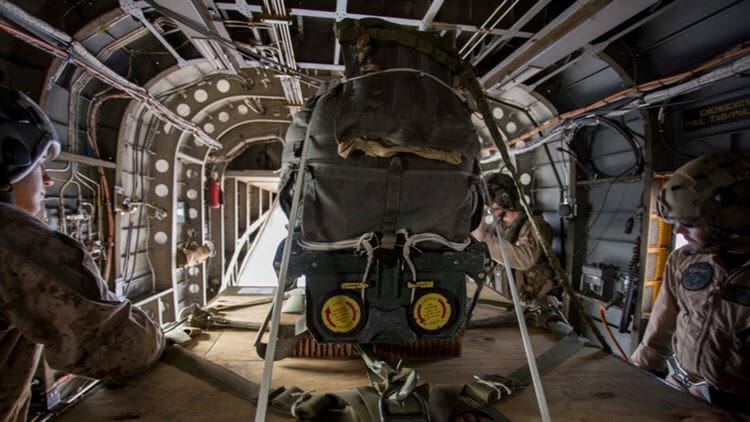MARINE CORPS BASE QUANTICO, Virginia— Marine Corps Systems Command fielded the last of 162 Joint Precision Airdrop Systems to the fleet in April, turning the page from acquisition to sustainment of the system for the Corps.

Marine parachute riggers with 1st Marine Logistics Group and a crew chief with Marine Operational Test and Evaluation Squadron-22 (VMX-22) prepare to deploy a palletized load from above 10,000 feet during the Joint Precision Airdrop System testing Aug. 1, at the U.S. Army Yuma Proving Ground. The JPADS systems use GPS, a modular autonomous guidance unit, or MAGU, a parachute and electric motors to guide cargo within 150 meters of their target points. Marine Corps Systems Command fielded the last of 162 JPADS to the fleet in April, turning the page from acquisition to sustainment of the system for the Corps. (U.S. Marine Corps photo by Cpl. Reba James)
When the JPADS 2K was introduced to the Marine Corps in 2008, it opened the door to a potentially life- saving capability for Marines on the ground and in the air. In 2013, the Corps upgraded to the 2K-Modular which included an improved modular autonomous guidance unit called the MAGU. JPADS 2K-M improved accuracy over traditional airdrops while simultaneously enabling aircraft to conduct drops at higher altitudes and longer distances from the drop zone.
“JPADS brings an important capability to Marines,” said Capt. Keith Rudolf, Aerial Delivery project officer with Marine Corps Systems Command’s Ground Combat Element Systems. “It’s not the answer for every situation, but the main goal is to keep people off the roads in an [improvised explosive device] environment or when small units are in locations that are not easily accessible by traditional logistic means.”
JPADS is ideal for cases where it is easier and safer to deliver equipment and supplies to ground units from the air versus using a convoy, Rudolf said.
“An average combat logistics patrol in Afghanistan that’s running behind a route clearance platoon may travel at only five to six miles an hour,” he said. “Depending on how much supply you have on there, you may have a mile worth of trucks that are slow-moving targets. [JPADS] negates a lot of that.”
The system also helps keep aircrews out of harm’s way.
“From the aircraft perspective, [JPADS] can be dropped from up to 25 kilometers away from the intended target, while still landing within 150 meters of the programed impact point,” Rudolf said. “Throughout testing, the systems often averaged much greater accuracy. That means the aircraft does not have to fly directly over a danger zone where they could be engaged with small arms or enemy threats on the ground. They can fly outside of that and because the system is autonomous, it will fly its best path down to where it needs to go.”



























































































































